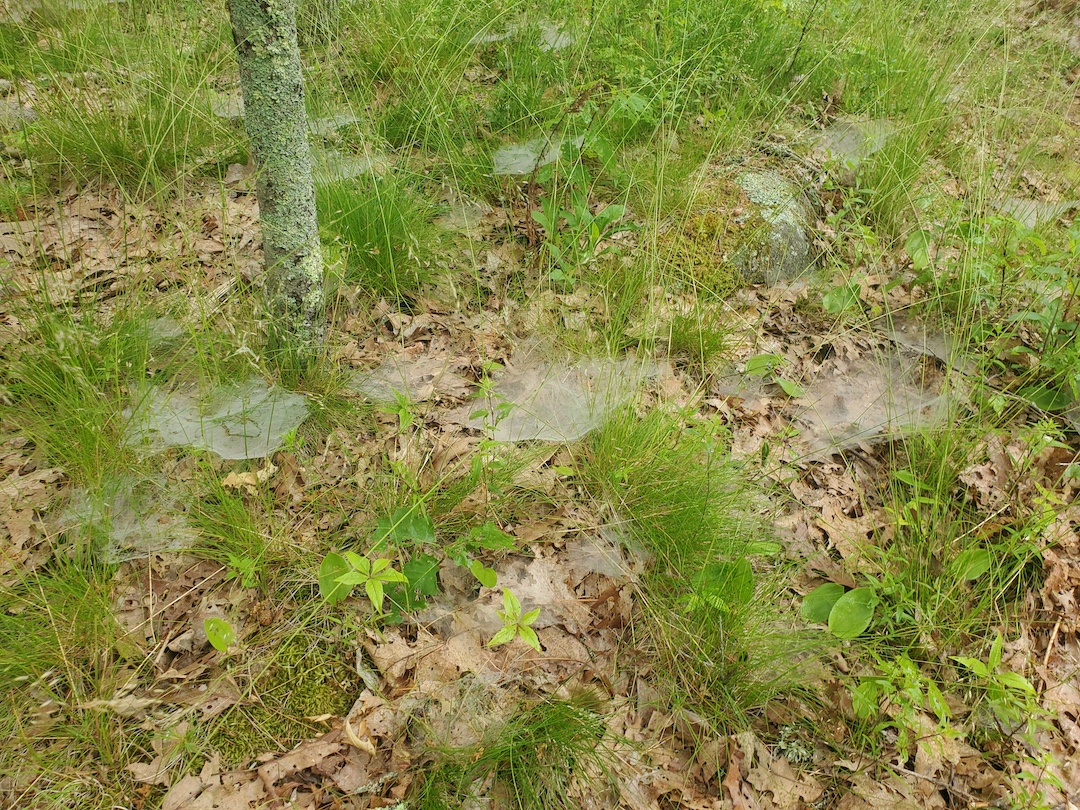June 30: A Stroll Among the Spider Webs
 On a recent cool and foggy morning, I stepped outside and saw a sight that would make any arachnophobe turn around and run back inside. Coating the grassy lawn and the leaf strewn forest were hundreds of small dew speckled spider webs. Slightly different in composition and placement then the standard spider web of dusty corners, these webs appeared as horizontal sheets on the ground. Being a fan of spiders, I decided to get a closer look at the handiwork of the species commonly known as the American grass spider or Funnel Weaver.
On a recent cool and foggy morning, I stepped outside and saw a sight that would make any arachnophobe turn around and run back inside. Coating the grassy lawn and the leaf strewn forest were hundreds of small dew speckled spider webs. Slightly different in composition and placement then the standard spider web of dusty corners, these webs appeared as horizontal sheets on the ground. Being a fan of spiders, I decided to get a closer look at the handiwork of the species commonly known as the American grass spider or Funnel Weaver.
When first examining the webs, it is difficult to find the spider. Unlike some species that sit out in the open, this spider hides inside a funnel. The funnel is built into one edge of the web, appearing as a small circular hole, which often bottlenecks into a shrub or dense grass. Glance inside the funnel and most likely you will find the spider, mottled brown or grey with stripes down its body. The spider spends a lot of time in the funnel as it provides shelter from the elements and protection from predators, while giving a place to feed and raise spiderlings.
As I strolled among the spider webs that morning, I saw some small black flies walking effortlessly over them, then fly away without any struggle. The actions of the flies appear counterintuitive to our knowledge that spider webs are sticky to ensnare prey. These webs are mats of entangling filaments that the spider laid down as it passed back and forth until it resembled a blanket. The filaments are not sticky but instead can snag on the body or leg of an insect. When the prey is on the springy web it produces vibrations which notifies the spider of the potential meal.
 These spiders are in the Genus Agelenopsis, a group of spiders known for being fast runners. They attack promising prey by rushing out at top speed and dispensing a paralyzing and poisonous bite. Once the prey has been disabled, the spider drags it back into the funnel and begins to feed. Funnel weavers are mostly active at night, but will collect prey whenever the web is triggered. The funnel has a built in emergency exit just in case the web is disturbed by a predator or curious human. Female spiders will usually stay in one single web for their lifetime, while males often roam about, sometimes seeking refuge underneath windowsills or inside homes.
These spiders are in the Genus Agelenopsis, a group of spiders known for being fast runners. They attack promising prey by rushing out at top speed and dispensing a paralyzing and poisonous bite. Once the prey has been disabled, the spider drags it back into the funnel and begins to feed. Funnel weavers are mostly active at night, but will collect prey whenever the web is triggered. The funnel has a built in emergency exit just in case the web is disturbed by a predator or curious human. Female spiders will usually stay in one single web for their lifetime, while males often roam about, sometimes seeking refuge underneath windowsills or inside homes.
Have you seen any of the Agelenopsis webs in your neck of the woods? While some folks suffer from a fear of spiders, we would do well to befriend these creatures. Maine has over 600 species of spider and none are truly poisonous to humans. They eat a lot of the bugs we consider pests and are part of the diet of frogs, birds, and other small animals. Spiders contribute to the overall health of a landscape, so next time you awaken to a foggy morning full of dew encrusted spider webs, take a moment to look a little closer.




